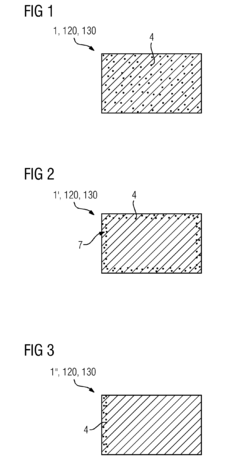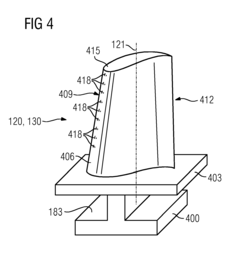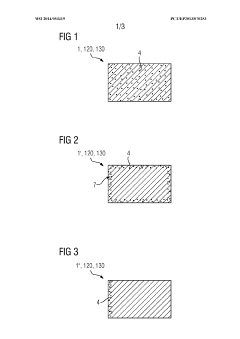Quasicrystal Influence on Modern Metamaterials
Quasicrystal Evolution
The evolution of quasicrystals has been a fascinating journey since their discovery in 1982 by Dan Shechtman. Initially met with skepticism, these aperiodic structures challenged the conventional understanding of crystallography and opened up new avenues in materials science. The timeline of quasicrystal evolution can be divided into several key phases, each marked by significant breakthroughs and expanding applications.
In the 1980s, the focus was primarily on understanding the fundamental nature of quasicrystals. Researchers worked to develop mathematical models to describe their unique structural properties, such as long-range order without periodicity. This period saw the development of the cut-and-project method and the discovery of various quasicrystalline alloys, including Al-Mn and Al-Cu-Fe systems.
The 1990s brought about a shift towards exploring the physical properties of quasicrystals. Scientists began investigating their electronic, magnetic, and optical characteristics. This era saw the first applications of quasicrystals in surface coatings due to their low friction and high hardness. Concurrently, theoretical work advanced, leading to a better understanding of phason dynamics and the role of defects in quasicrystalline structures.
The turn of the millennium marked the beginning of engineered quasicrystals. Researchers started to manipulate quasicrystalline structures at the nanoscale, paving the way for their integration into metamaterials. This period saw the first demonstrations of photonic quasicrystals, which exhibited unique light-manipulation properties due to their aperiodic nature.
From 2010 onwards, the field has experienced a renaissance, particularly in the context of metamaterials. The aperiodic nature of quasicrystals has been leveraged to create metamaterials with unprecedented electromagnetic and acoustic properties. This has led to advancements in areas such as superlensing, cloaking, and negative refractive index materials.
Recent years have seen a convergence of quasicrystal research with other cutting-edge fields. The discovery of natural quasicrystals in meteorites has opened up new questions about their formation in extraterrestrial environments. Additionally, the potential of quasicrystals in quantum computing applications has emerged as a promising area of study, with researchers exploring their unique electronic states for quantum information processing.
Throughout this evolution, computational methods have played an increasingly crucial role. Advanced simulation techniques have allowed for the prediction and design of new quasicrystalline structures, accelerating the pace of discovery and application development. This computational approach has been particularly impactful in the field of metamaterials, where quasicrystalline patterns can be precisely engineered to achieve desired electromagnetic responses.
Metamaterial Market
The metamaterial market has experienced significant growth in recent years, driven by advancements in nanotechnology, material science, and the increasing demand for innovative solutions across various industries. The global metamaterial market size was valued at approximately $316 million in 2020 and is projected to reach $3.61 billion by 2030, growing at a CAGR of 27.6% during the forecast period.
The market for metamaterials is segmented based on application areas, including antenna and radar systems, sensors, cloaking devices, seismic protection, and sound filtering. Among these, antenna and radar systems currently dominate the market share, accounting for over 30% of the total revenue. This dominance is attributed to the growing adoption of metamaterials in telecommunications and defense sectors for enhancing signal processing and improving communication efficiency.
Geographically, North America holds the largest market share, followed by Europe and Asia-Pacific. The United States, in particular, is at the forefront of metamaterial research and development, supported by substantial investments from both government and private sectors. However, the Asia-Pacific region is expected to witness the highest growth rate in the coming years, driven by increasing research activities and growing industrial applications in countries like China, Japan, and South Korea.
Key players in the metamaterial market include Metamaterial Technologies Inc., Kymeta Corporation, Phoebus Optoelectronics LLC, and Echodyne Corporation. These companies are actively involved in developing innovative metamaterial-based products and solutions, focusing on areas such as electromagnetic wave manipulation, acoustic cloaking, and energy harvesting.
The integration of quasicrystals in modern metamaterials is expected to further expand market opportunities. Quasicrystalline metamaterials offer unique properties such as enhanced light manipulation, improved electromagnetic absorption, and novel photonic applications. This emerging field is attracting significant research interest and investment, potentially opening new avenues for market growth in sectors like optics, telecommunications, and energy.
Challenges in the metamaterial market include high production costs, complex manufacturing processes, and the need for specialized expertise. However, ongoing research and development efforts are focused on addressing these issues, with advancements in 3D printing and nanofabrication techniques showing promise in reducing production costs and improving scalability.
Quasicrystal Challenges
The integration of quasicrystals into modern metamaterials presents several significant challenges that researchers and engineers must overcome. One of the primary obstacles is the complexity of quasicrystalline structures, which lack the periodicity of traditional crystals. This non-periodic nature makes it difficult to predict and control the behavior of quasicrystals when incorporated into metamaterials, particularly in terms of their electromagnetic and optical properties.
Another major challenge lies in the fabrication of quasicrystal-based metamaterials. Traditional manufacturing techniques often rely on periodic structures, making the production of quasicrystalline patterns at the nanoscale a formidable task. Advanced fabrication methods such as electron-beam lithography and self-assembly techniques are being explored, but they still face limitations in terms of scalability and precision.
The characterization of quasicrystal-metamaterial composites poses yet another hurdle. Conventional analytical tools and simulation methods are often inadequate for accurately modeling and measuring the unique properties of these complex structures. This necessitates the development of new computational algorithms and experimental techniques specifically tailored to quasicrystalline systems.
Furthermore, the integration of quasicrystals with existing metamaterial designs presents compatibility issues. The distinct symmetry and structural properties of quasicrystals may not always align with the desired functionalities of metamaterials, requiring careful engineering to achieve synergistic effects without compromising performance.
The multiscale nature of quasicrystal-metamaterial systems also presents a significant challenge. Bridging the gap between the atomic-scale structure of quasicrystals and the macroscopic properties of metamaterials requires a comprehensive understanding of phenomena across multiple length scales, from nanometers to millimeters.
Lastly, the optimization of quasicrystal-metamaterial designs for specific applications remains a complex task. The vast parameter space and non-intuitive behavior of these systems make it challenging to fine-tune their properties for desired functionalities, such as negative refraction, superlensing, or electromagnetic cloaking.
Addressing these challenges requires interdisciplinary collaboration among materials scientists, physicists, engineers, and computational experts. As research progresses, overcoming these obstacles will be crucial for unlocking the full potential of quasicrystals in advancing metamaterial technology and enabling novel applications in fields such as optics, telecommunications, and energy harvesting.
Quasicrystal Solutions
01 Synthesis and production of quasicrystals
Methods for synthesizing and producing quasicrystalline materials, including techniques for controlling composition, structure, and properties. This involves various processing methods such as rapid solidification, vapor deposition, and mechanical alloying to create stable quasicrystalline phases.- Synthesis and production of quasicrystals: Methods for synthesizing and producing quasicrystalline materials, including techniques for controlling composition, structure, and properties. This involves various processes such as rapid solidification, vapor deposition, and mechanical alloying to create stable quasicrystalline phases.
- Applications of quasicrystals in coatings and surface treatments: Utilization of quasicrystalline materials in coatings and surface treatments to enhance properties such as wear resistance, corrosion protection, and thermal insulation. This includes methods for applying quasicrystalline coatings to various substrates and their use in specific industrial applications.
- Quasicrystal-based composites and alloys: Development of composite materials and alloys incorporating quasicrystalline phases to achieve unique combinations of properties. This includes the design of metal matrix composites, bulk metallic glasses, and other advanced materials with improved mechanical, thermal, or electrical characteristics.
- Optical and photonic applications of quasicrystals: Exploration of quasicrystals in optical and photonic devices, leveraging their unique structural properties for applications such as light manipulation, photonic bandgap materials, and novel optical coatings. This includes the design and fabrication of quasicrystal-based optical components and devices.
- Characterization and analysis techniques for quasicrystals: Advanced methods for characterizing and analyzing quasicrystalline materials, including electron microscopy, X-ray diffraction, and computational modeling techniques. These approaches enable the study of quasicrystal structure, composition, and properties at various scales.
02 Applications of quasicrystals in coatings and surface treatments
Utilization of quasicrystalline materials in coatings and surface treatments to enhance properties such as wear resistance, corrosion protection, and thermal insulation. This includes methods for applying quasicrystalline coatings to various substrates and their use in specific industrial applications.Expand Specific Solutions03 Quasicrystal-based composites and alloys
Development of composite materials and alloys incorporating quasicrystalline phases to achieve unique combinations of properties. This includes the design of metal matrix composites, bulk metallic glasses, and other advanced materials with improved mechanical, thermal, or electrical characteristics.Expand Specific Solutions04 Optical and photonic applications of quasicrystals
Exploration of quasicrystals in optical and photonic devices, leveraging their unique structural properties for applications such as light manipulation, photonic bandgap materials, and novel optical coatings. This includes the design and fabrication of quasicrystal-based optical components and devices.Expand Specific Solutions05 Characterization and analysis techniques for quasicrystals
Advanced methods for characterizing and analyzing quasicrystalline materials, including electron microscopy, X-ray diffraction, and computational modeling techniques. These approaches enable researchers to study the unique structural and physical properties of quasicrystals in detail.Expand Specific Solutions
Metamaterial Players
The field of quasicrystal influence on modern metamaterials is in a nascent stage of development, with significant potential for growth. The market size is expanding as researchers explore novel applications in optics, electronics, and materials science. While the technology is still emerging, several key players are advancing its maturity. Institutions like National Institute for Materials Science IAI, Nanjing University, and Oxford University Innovation Ltd. are at the forefront of research. Companies such as Siemens Corp., Toyota Motor Corp., and 3M Innovative Properties Co. are investing in practical applications. The involvement of diverse entities, from academic institutions to major corporations, indicates a competitive landscape with opportunities for breakthrough innovations in metamaterial design and functionality.
National Institute for Materials Science IAI
Oxford University Innovation Ltd.
Quasicrystal Patents
- Incorporating quasi-crystal particles into metal alloys, which have tunable properties between metals and ceramics, minimizing thermal stresses and enhancing mechanical strength, abrasion resistance, and providing thermal insulation through controlled surface concentration gradients.
- Incorporating quasi-crystal particles into metal alloys, which have tunable properties between metals and ceramics, minimizing thermal stresses and enhancing mechanical stability, while also providing thermal insulation through controlled surface concentration gradients.
Fabrication Techniques
The fabrication of quasicrystal-inspired metamaterials presents unique challenges due to their complex, aperiodic structures. Traditional manufacturing methods often struggle to produce the intricate patterns and precise geometries required for these advanced materials. However, recent advancements in fabrication techniques have opened new possibilities for realizing quasicrystalline metamaterials with unprecedented accuracy and scalability.
One of the most promising approaches is electron beam lithography (EBL), which allows for the creation of nanoscale features with high precision. EBL can produce quasicrystalline patterns with feature sizes down to 10 nm, enabling the fabrication of metamaterials that operate at optical and near-infrared frequencies. This technique is particularly valuable for creating planar quasicrystalline structures, such as metasurfaces with unique electromagnetic properties.
Focused ion beam (FIB) milling has also emerged as a powerful tool for fabricating three-dimensional quasicrystalline metamaterials. FIB allows for the direct writing and etching of complex structures with nanometer-scale resolution. This technique is especially useful for creating quasicrystalline photonic crystals and plasmonic nanostructures that exhibit novel optical properties.
For larger-scale production, nanoimprint lithography (NIL) has shown promise in replicating quasicrystalline patterns over large areas. NIL combines the high resolution of EBL with the throughput of traditional stamping techniques, making it suitable for mass production of quasicrystal-inspired metamaterials. This method has been successfully used to create quasicrystalline plasmonic surfaces with applications in sensing and light manipulation.
Additive manufacturing techniques, such as two-photon polymerization (2PP), have also been adapted for fabricating three-dimensional quasicrystalline metamaterials. 2PP allows for the creation of complex 3D structures with sub-micron resolution, enabling the realization of volumetric quasicrystalline designs that were previously impossible to manufacture.
Recent developments in self-assembly methods have opened up new avenues for bottom-up fabrication of quasicrystalline metamaterials. DNA origami and colloidal self-assembly techniques have been used to create nanoscale quasicrystalline structures with precise control over particle positioning and orientation. These approaches offer the potential for large-scale, cost-effective production of quasicrystalline metamaterials with unique optical and mechanical properties.
As fabrication techniques continue to evolve, the integration of multiple methods is becoming increasingly common. Hybrid approaches combining top-down and bottom-up techniques are enabling the creation of hierarchical quasicrystalline structures that span multiple length scales. These multi-scale fabrication strategies are crucial for realizing the full potential of quasicrystal-inspired metamaterials in practical applications.
Quantum Applications
The intersection of quasicrystals and quantum applications represents a frontier in materials science with profound implications for quantum technologies. Quasicrystals, with their aperiodic yet ordered structures, offer unique properties that can be harnessed in quantum systems. Their non-periodic nature creates localized electronic states and unusual energy band structures, which can be exploited for quantum information processing and quantum sensing applications.
In quantum computing, quasicrystal-based metamaterials show promise for creating novel qubit architectures. The inherent symmetry of quasicrystals can lead to protected quantum states, potentially increasing coherence times and reducing error rates in quantum computations. These materials may also serve as efficient quantum memory devices, leveraging their unique electronic properties to store and manipulate quantum information.
Quantum sensing is another area where quasicrystal-influenced metamaterials could make significant contributions. The distinct local environments within quasicrystals can enhance sensitivity to external fields, making them ideal candidates for quantum magnetometers and other high-precision sensing devices. Their unusual phonon spectra may also be utilized in quantum optomechanical systems, enabling novel approaches to quantum-limited measurements.
In the realm of quantum communication, metamaterials inspired by quasicrystalline structures could lead to the development of more efficient quantum repeaters and improved quantum key distribution systems. The ability to engineer specific electromagnetic responses in these materials may allow for the creation of quantum-compatible waveguides and antennas with enhanced performance characteristics.
Furthermore, the study of quasicrystals in metamaterials opens up new avenues for exploring fundamental quantum phenomena. Their complex structural order provides a unique platform for investigating quantum many-body effects, topological quantum states, and exotic quasiparticles. This fundamental research could lead to the discovery of new quantum phases of matter and novel quantum effects with potential technological applications.
As quantum technologies continue to advance, the integration of quasicrystal-inspired metamaterials into quantum devices may become increasingly important. These materials offer a rich playground for engineering quantum states and interactions, potentially leading to breakthroughs in quantum information science and quantum metrology. The ongoing research in this field promises to unlock new capabilities in quantum applications, pushing the boundaries of what is possible in quantum technologies.






